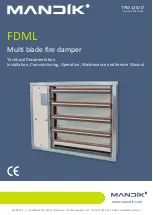
www.actionair.co.uk
January 2017
Health and Safety
This process must be undertaken by competent
persons. More than one person may be required to
ensure the safe handling of large dampers and other
materials. Use must be made of access equipment
to ensure unsafe practices are not used to approach
walls or difficult access areas.
Standard site PPE should be used (minimum steel
toe cap boots, hard hat); together with any protective
eyewear, gloves and masks, when drilling or cutting
is being undertaken. The latter should also be used
when handing the wall construction materials, as
defined by the material suppliers. If loud equipment
is being used, hearing protection should be used.
All waste materials should be collected and
disposed of as defined by the relevant supplier.
Vertical in Block Work/Masonry Wall -
HEVAC/HVCA Installation Frame (IF)
Damper installation method
1. Measure the positions of the building ties on
the HEVAC frame
2. Mark up the lintel at the top of the hole in the wall
to give positions that match to the building ties. Drill
into the lintel and fit stud anchors (not supplied) or
similar steel fixings e.g. Loden anchors - loop head
min Ø6.5mm x 63mm.
3. Turn out the building ties on the damper and place
damper into position, supporting from underneath
with a block of wood or board, which will need to
be removed when the mortar is in position.
4. If 4 hour Integrity is required pockets in the wall
will be required and wall ties turned out into them.
5. Using a Ø1.5mm steel wire (not supplied) wrap this
round the building ties and the stud anchors in the
lintel at the top to hold the damper in position. (Note:
This will also maintain the quality of the link between
the damper, infill mortar and the wall if a fire occurs)
6. Add mortar from both sides of the damper and infill
to the HEVAC frame. Take care not to infill past the
line on the interface shroud.
SmokeShield PTC & FireShield Dampers
HEVAC Frame (I/F) Installation Method
SmokeShield PTC - ES Rated Fire Damper (Fire & Smoke Barrier)
FireShield - E Rated Fire Damper (Fire Barrier)









